Completely master mysql multi-table operations
This article brings you relevant knowledge about mysql, which mainly introduces issues related to multi-table operations, including multi-table relationships, foreign key constraints, multi-table joint queries, internal Connection query and outer connection query, etc. I hope it will be helpful to everyone.

Recommended learning: mysql tutorial
Multi-table relationship
One-to-one (usually merged tables) ,
One-to-many/many-to-one (departments and employees),
Many-to-many (students and courses) - using intermediate tables
Foreign key constraint concept
Specialized Constraints for multi-table relationships
Control the foreign keys of the slave table through the primary key of the master table
Foreign key constraints:
1. The master table must already exist, or Creating
2. The primary key column must be set for the main table
3. The primary key cannot include null values, but the foreign key can include null values
4. Specify the column after the table name of the main table or A combination of column names. This column or combination of columns must be the primary key or candidate key of the main table
5. The number of columns in the foreign key must be the same as the number of columns in the primary key
6. The data type of the columns in the foreign key must be the same as the number of columns in the primary key The data types of the corresponding columns are the same
• Create foreign key constraintsforeign key
Add foreign key constraints before creating the table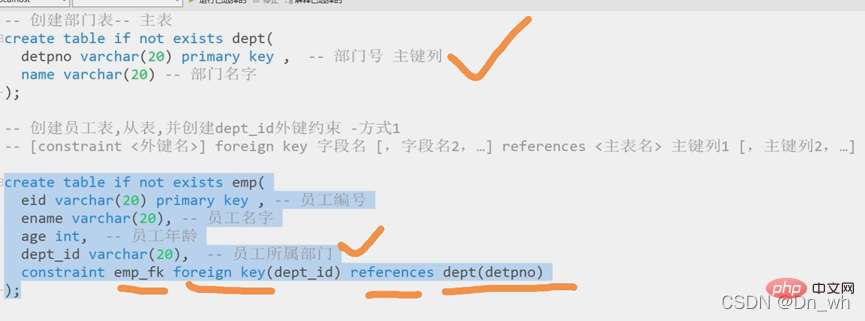
Add foreign key constraints after creating the table

Verify the role of foreign key constraints
1. Data insertion:
You must first add it to the main table Constraints
Adding constraints from the slave table depends on the master table. Data that does not exist in the master table cannot be added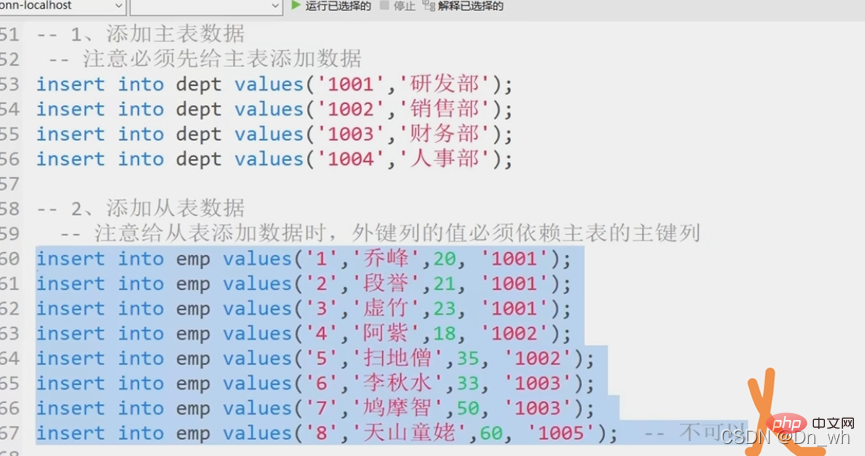
2. Data deletion
When the data of the master table is dependent on the slave table, It cannot be deleted, otherwise it can be deleted
The data from the table can be deleted arbitrarily
eg:
delete from dept where deptno = '1001';-----不可以删除(被依赖了)delete from dept where deptno = '1004'; ------可以删除delete from emp where eid = '7'; -----可以删除
Delete the foreign key constraint
After deletion, there will be a gap between the tables. It doesn’t matter anymore
Syntax:
alter table 表名字 drop foreign key 外键约束名alter table emp2 drop foreign key emp2_fk;
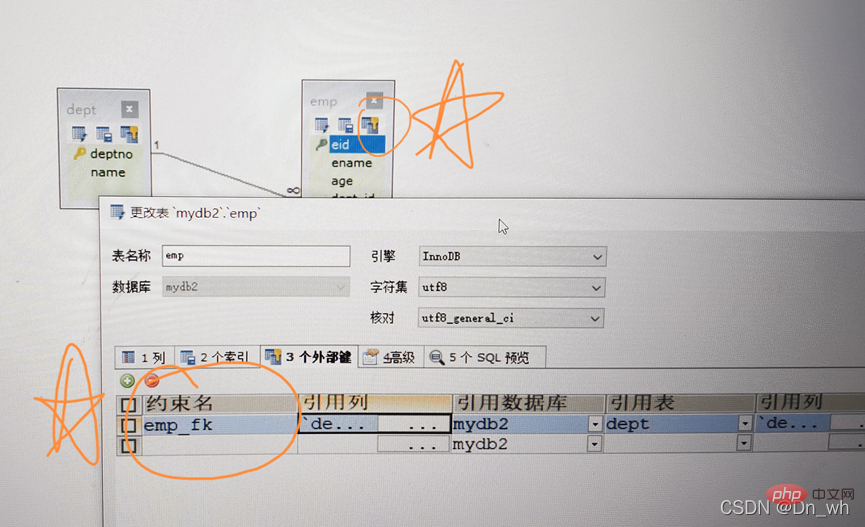
• Many-to-many relationship - constructing foreign key constraints
One row of table A corresponds to multiple rows of table B, and table B One row of corresponds to multiple rows of table A. At this time, you need to re-create an intermediate table to record the table relationship
Note:
Modify and When deleting, the middle slave table can be deleted and modified at will, but the data relied on by the slave tables on both sides and the master table cannot be deleted or modified.
Multi-table joint query (very important)
• Concept
is to query two or more tables at the same time, because sometimes users When viewing data, the data that needs to be displayed comes from multiple tables
Note:
Foreign key constraints only affect the addition, deletion and modification of data and have no effect on data query
select * from A,B;---redundant data will be generated
two tables The Cartesian product of all data rows 2. The Cartesian set can be understood as each row of one table matching any row of another table
3. Suppose table A has m rows of data , table B has n rows of data, then
m * n rows of data will be returned. 4. Cartesian product will produce a lot of
redundant data, and other subsequent queries can be done in this Conditional filtering based on the set
intersection between the two tables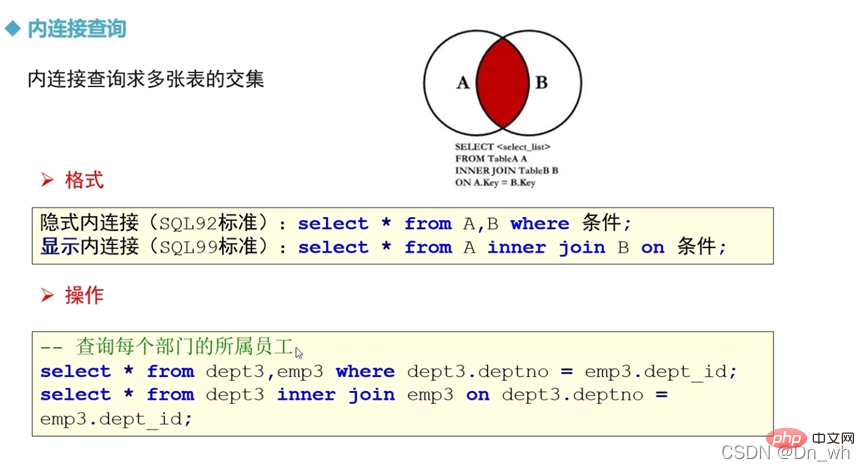
inner You can omit
select * from A,B where 条件;
select * from A inner join B on 条件
---查询每个部门的所属员工 //隐式内连接
select* from dept3,emp3 where dept3.deptno = emp3.dept_id; //这样写标准
select* from dept3 a ,emp3 b where a.deptno = b.dept_id;
---查询每个部门的所属员工 //显式内连接select *from dept3 inner join emp3 on dept3.deptno = emp3.dept_id; //这样写标准
select *from dept3 a join emp3 b on a.deptno = b.dept_id;

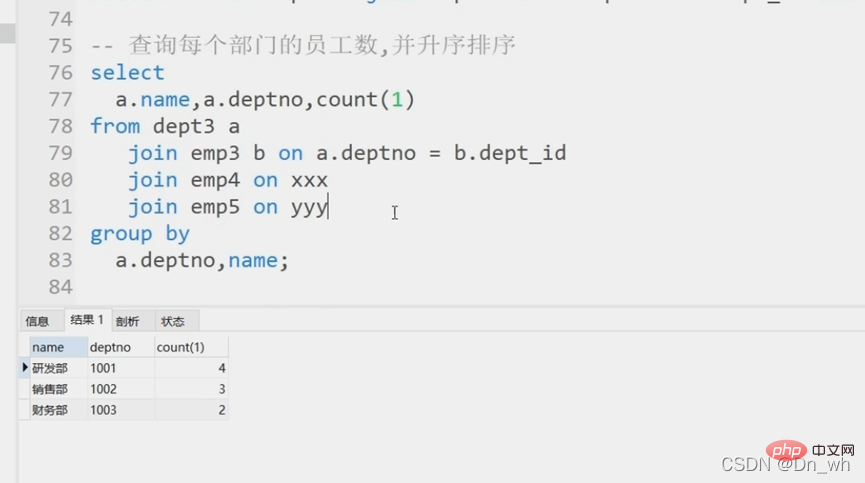
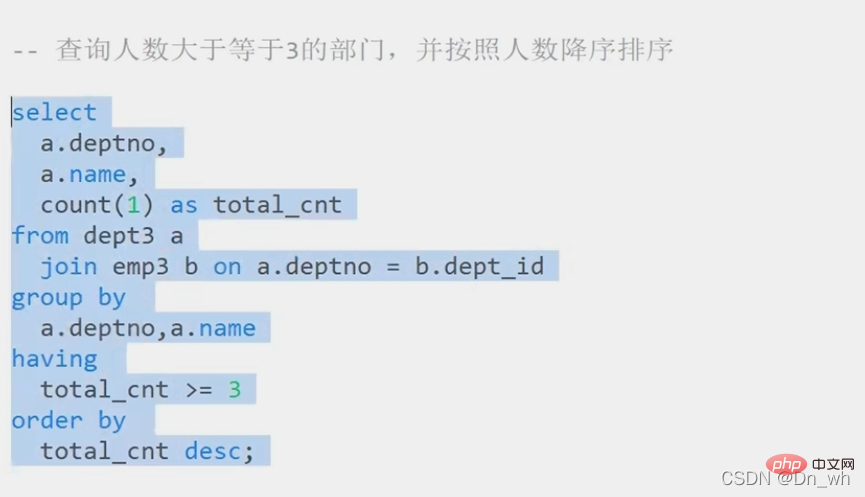
Left outer join
left outer join、
select* from A left outer join B on 条件;
right outer join、
select* from A right outer join B on 条件;
full outer join
select* from A full outer join B on 条件;
注意:
Oracle 里面有 full join ,可是在mysql 对 full join 支持的不好,我们可以使用 union来达到目的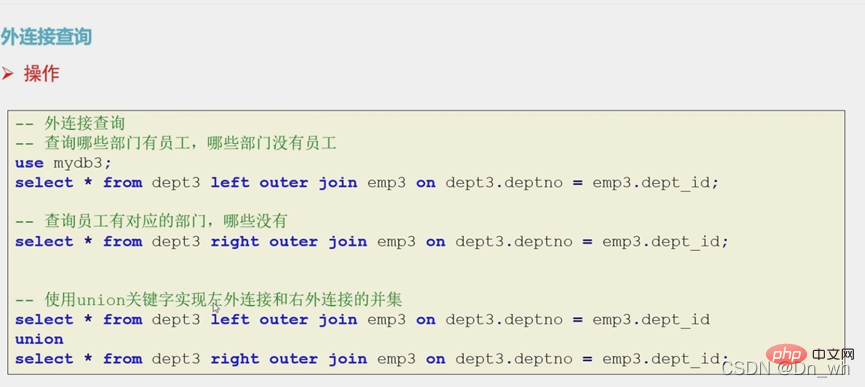
----外连接查询
----查询哪些部门有员工,哪些部门没有员工
use mydb3;select* from dept3 left outer join emp3 on dept3.deptno =emp3.dept_id;
----查询哪些员工有对应的部门,哪些没有
select* from dept3 right outer join emp3 on dept3.deptno =emp3.dept_id;
----使用 union 关键字实现左外连接和右外连接的并集
select* from dept3 left outer join emp3 on dept3.deptno=emp3.dept_idunionselect* from dept3 right outer join emp3 on dept3.deptno =emp3.dept_id;

----外连接查询
----查询哪些部门有员工,哪些部门没有员工
usemydb3;select* from dept3 a left outer join emp3 b on a.deptno = b.dept.idselect* from dept3 a left join emp3 b on a.deptno = b.dept_id;
----外连接多个表
select* from Aleft join B on 条件1left join C on 条件2left join D on 条件3;
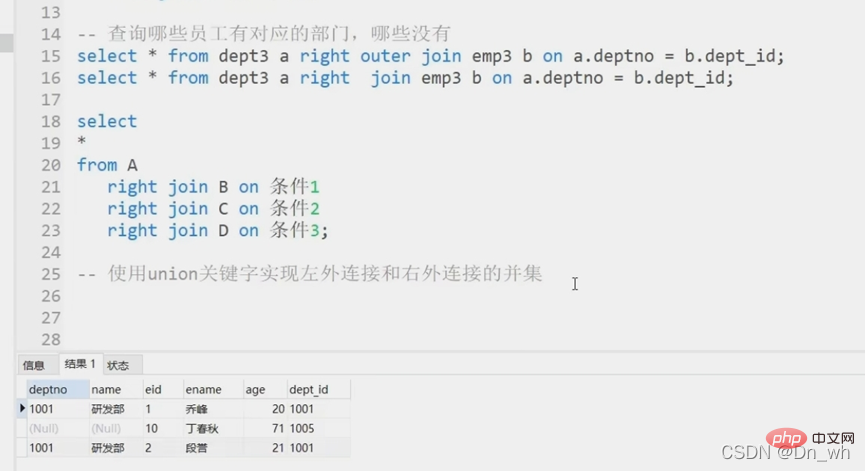
----查询哪些员工有对应的部门,哪些没有
select * from dept3 a right outer join emp3 b on a.deptno = b.dept_id;select* from dept3 a right join emp3 b on a.deptno = b,dept_id;select*from Aright joinB on条件1,right joinC on条件2,right joinD on条件3;
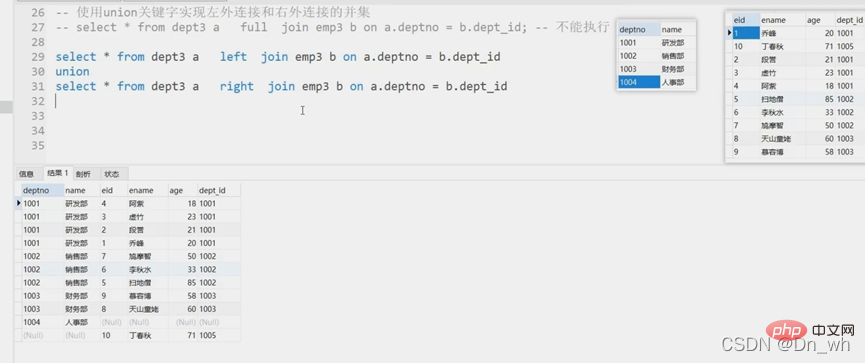
----实现满外连接: full join
----使用 union 关键字实现左外连接和右外连接的并集
----select * from dept3 a full join emp3 b on a.deptno = b.dept_id; --不能执行
----union是将两个查询结果上下拼接,并去重
select* from dept3 a left join emp3 b on a.deptno = b.dept_idunionselect* from dept3 a right join emp3 b on a.deptno = b.dept_id
----union all 是将两个查询结果上下拼接,不去重
select* from dept3 a left join emp3 b on a.deptno = b.dept_idunion allselect* from dept3 a right join emp3 b on a.deptno= b.dept_id
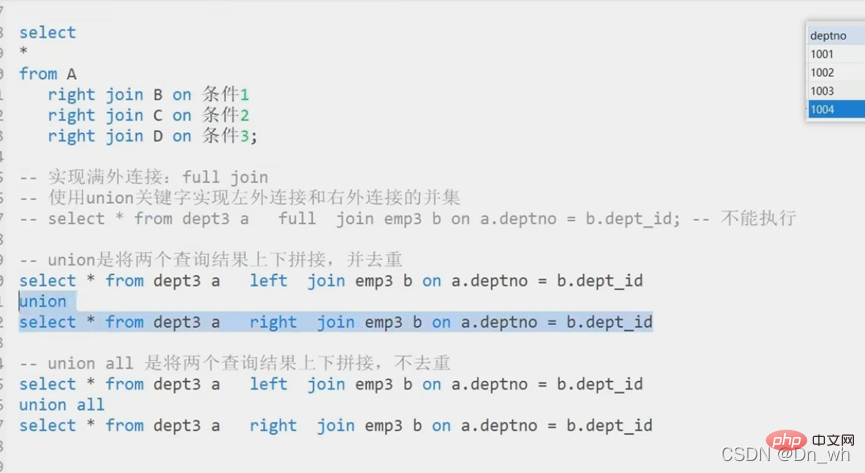
• 基本子查询
• 子查询关键字-ALL
• 子查询关键字-ANY ,SOME
• 子查询关键字-IN
• 子查询关键字-EXISTS
• 自关联查询
推荐学习:mysql视频教程
The above is the detailed content of Completely master mysql multi-table operations. For more information, please follow other related articles on the PHP Chinese website!

Hot AI Tools

Undresser.AI Undress
AI-powered app for creating realistic nude photos

AI Clothes Remover
Online AI tool for removing clothes from photos.

Undress AI Tool
Undress images for free

Clothoff.io
AI clothes remover

AI Hentai Generator
Generate AI Hentai for free.

Hot Article

Hot Tools

Notepad++7.3.1
Easy-to-use and free code editor

SublimeText3 Chinese version
Chinese version, very easy to use

Zend Studio 13.0.1
Powerful PHP integrated development environment

Dreamweaver CS6
Visual web development tools

SublimeText3 Mac version
God-level code editing software (SublimeText3)

Hot Topics
 1382
1382
 52
52
 MySQL: Simple Concepts for Easy Learning
Apr 10, 2025 am 09:29 AM
MySQL: Simple Concepts for Easy Learning
Apr 10, 2025 am 09:29 AM
MySQL is an open source relational database management system. 1) Create database and tables: Use the CREATEDATABASE and CREATETABLE commands. 2) Basic operations: INSERT, UPDATE, DELETE and SELECT. 3) Advanced operations: JOIN, subquery and transaction processing. 4) Debugging skills: Check syntax, data type and permissions. 5) Optimization suggestions: Use indexes, avoid SELECT* and use transactions.
 How to open phpmyadmin
Apr 10, 2025 pm 10:51 PM
How to open phpmyadmin
Apr 10, 2025 pm 10:51 PM
You can open phpMyAdmin through the following steps: 1. Log in to the website control panel; 2. Find and click the phpMyAdmin icon; 3. Enter MySQL credentials; 4. Click "Login".
 MySQL: An Introduction to the World's Most Popular Database
Apr 12, 2025 am 12:18 AM
MySQL: An Introduction to the World's Most Popular Database
Apr 12, 2025 am 12:18 AM
MySQL is an open source relational database management system, mainly used to store and retrieve data quickly and reliably. Its working principle includes client requests, query resolution, execution of queries and return results. Examples of usage include creating tables, inserting and querying data, and advanced features such as JOIN operations. Common errors involve SQL syntax, data types, and permissions, and optimization suggestions include the use of indexes, optimized queries, and partitioning of tables.
 Why Use MySQL? Benefits and Advantages
Apr 12, 2025 am 12:17 AM
Why Use MySQL? Benefits and Advantages
Apr 12, 2025 am 12:17 AM
MySQL is chosen for its performance, reliability, ease of use, and community support. 1.MySQL provides efficient data storage and retrieval functions, supporting multiple data types and advanced query operations. 2. Adopt client-server architecture and multiple storage engines to support transaction and query optimization. 3. Easy to use, supports a variety of operating systems and programming languages. 4. Have strong community support and provide rich resources and solutions.
 How to use single threaded redis
Apr 10, 2025 pm 07:12 PM
How to use single threaded redis
Apr 10, 2025 pm 07:12 PM
Redis uses a single threaded architecture to provide high performance, simplicity, and consistency. It utilizes I/O multiplexing, event loops, non-blocking I/O, and shared memory to improve concurrency, but with limitations of concurrency limitations, single point of failure, and unsuitable for write-intensive workloads.
 MySQL's Place: Databases and Programming
Apr 13, 2025 am 12:18 AM
MySQL's Place: Databases and Programming
Apr 13, 2025 am 12:18 AM
MySQL's position in databases and programming is very important. It is an open source relational database management system that is widely used in various application scenarios. 1) MySQL provides efficient data storage, organization and retrieval functions, supporting Web, mobile and enterprise-level systems. 2) It uses a client-server architecture, supports multiple storage engines and index optimization. 3) Basic usages include creating tables and inserting data, and advanced usages involve multi-table JOINs and complex queries. 4) Frequently asked questions such as SQL syntax errors and performance issues can be debugged through the EXPLAIN command and slow query log. 5) Performance optimization methods include rational use of indexes, optimized query and use of caches. Best practices include using transactions and PreparedStatemen
 MySQL and SQL: Essential Skills for Developers
Apr 10, 2025 am 09:30 AM
MySQL and SQL: Essential Skills for Developers
Apr 10, 2025 am 09:30 AM
MySQL and SQL are essential skills for developers. 1.MySQL is an open source relational database management system, and SQL is the standard language used to manage and operate databases. 2.MySQL supports multiple storage engines through efficient data storage and retrieval functions, and SQL completes complex data operations through simple statements. 3. Examples of usage include basic queries and advanced queries, such as filtering and sorting by condition. 4. Common errors include syntax errors and performance issues, which can be optimized by checking SQL statements and using EXPLAIN commands. 5. Performance optimization techniques include using indexes, avoiding full table scanning, optimizing JOIN operations and improving code readability.
 How to build a SQL database
Apr 09, 2025 pm 04:24 PM
How to build a SQL database
Apr 09, 2025 pm 04:24 PM
Building an SQL database involves 10 steps: selecting DBMS; installing DBMS; creating a database; creating a table; inserting data; retrieving data; updating data; deleting data; managing users; backing up the database.




